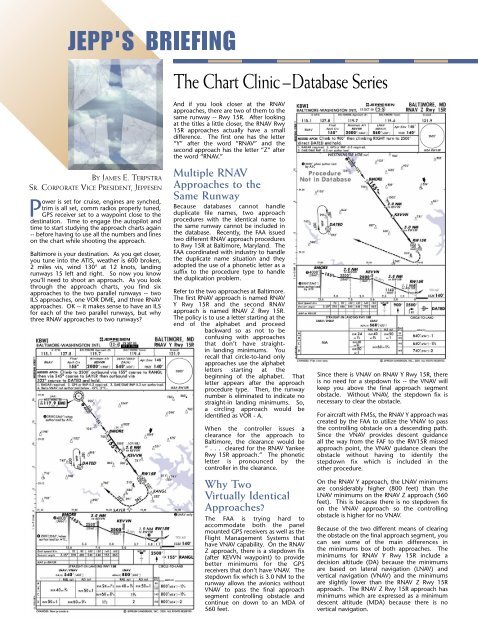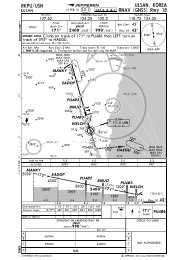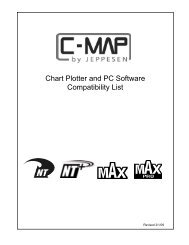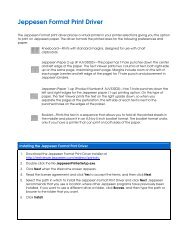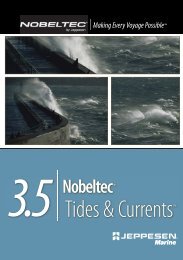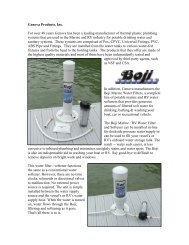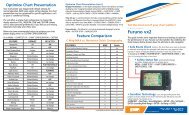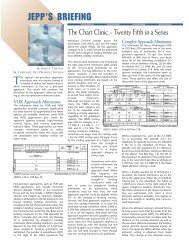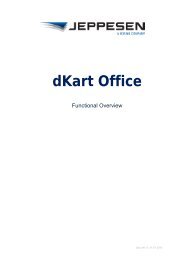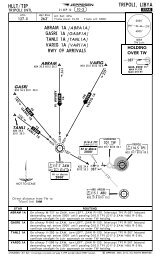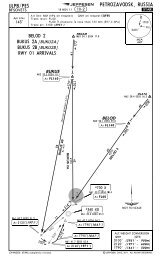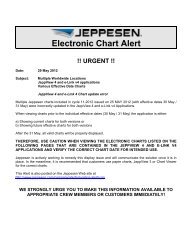The Chart Clinic – Database Series - Jeppesen
The Chart Clinic – Database Series - Jeppesen
The Chart Clinic – Database Series - Jeppesen
You also want an ePaper? Increase the reach of your titles
YUMPU automatically turns print PDFs into web optimized ePapers that Google loves.
BY JAMES E. TERPSTRA<br />
SR. CORPORATE VICE PRESIDENT, JEPPESEN<br />
P<br />
ower is set for cruise, engines are synched,<br />
trim is all set, comm radios properly tuned,<br />
GPS receiver set to a waypoint close to the<br />
destination. Time to engage the autopilot and<br />
time to start studying the approach charts again<br />
-- before having to use all the numbers and lines<br />
on the chart while shooting the approach.<br />
Baltimore is your destination. As you get closer,<br />
you tune into the ATIS, weather is 600 broken,<br />
2 miles vis, wind 130° at 12 knots, landing<br />
runways 15 left and right. So now you know<br />
you’ll need to shoot an approach. As you look<br />
through the approach charts, you find six<br />
approaches to the two parallel runways -- two<br />
ILS approaches, one VOR DME, and three RNAV<br />
approaches. OK -- it makes sense to have an ILS<br />
for each of the two parallel runways, but why<br />
three RNAV approaches to two runways?<br />
<strong>The</strong> <strong>Chart</strong> <strong>Clinic</strong> <strong>–</strong> <strong>Database</strong> <strong>Series</strong><br />
And if you look closer at the RNAV<br />
approaches, there are two of them to the<br />
same runway -- Rwy 15R. After looking<br />
at the titles a little closer, the RNAV Rwy<br />
15R approaches actually have a small<br />
difference. <strong>The</strong> first one has the letter<br />
“Y” after the word “RNAV” and the<br />
second approach has the letter “Z” after<br />
the word “RNAV.”<br />
Multiple RNAV<br />
Approaches to the<br />
Same Runway<br />
Because databases cannot handle<br />
duplicate file names, two approach<br />
procedures with the identical name to<br />
the same runway cannot be included in<br />
the database. Recently, the FAA issued<br />
two different RNAV approach procedures<br />
to Rwy 15R at Baltimore, Maryland. <strong>The</strong><br />
FAA coordinated with industry to handle<br />
the duplicate name situation and they<br />
adopted the use of a phonetic letter as a<br />
suffix to the procedure type to handle<br />
the duplication problem.<br />
Refer to the two approaches at Baltimore.<br />
<strong>The</strong> first RNAV approach is named RNAV<br />
Y Rwy 15R and the second RNAV<br />
approach is named RNAV Z Rwy 15R.<br />
<strong>The</strong> policy is to use a letter starting at the<br />
end of the alphabet and proceed<br />
backward so as not to be<br />
confusing with approaches<br />
that don’t have straightin<br />
landing minimums. You<br />
recall that circle-to-land only<br />
approaches use the alphabet<br />
letters starting at the<br />
beginning of the alphabet. That<br />
letter appears after the approach<br />
procedure type. <strong>The</strong>n, the runway<br />
number is eliminated to indicate no<br />
straight-in landing minimums. So,<br />
a circling approach would be<br />
identified as VOR - A.<br />
When the controller issues a<br />
clearance for the approach to<br />
Baltimore, the clearance would be<br />
“ . . . cleared for the RNAV Yankee<br />
Rwy 15R approach.” <strong>The</strong> phonetic<br />
letter is pronounced by the<br />
controller in the clearance.<br />
Why Two<br />
Virtually Identical<br />
Approaches?<br />
<strong>The</strong> FAA is trying hard to<br />
accommodate both the panel<br />
mounted GPS receivers as well as the<br />
Flight Management Systems that<br />
have VNAV capability. On the RNAV<br />
Z approach, there is a stepdown fix<br />
(after KEVVN waypoint) to provide<br />
better minimums for the GPS<br />
receivers that don’t have VNAV. <strong>The</strong><br />
stepdown fix which is 3.0 NM to the<br />
runway allows the avionics without<br />
VNAV to pass the final approach<br />
segment controlling obstacle and<br />
continue on down to an MDA of<br />
560 feet.<br />
Since there is VNAV on RNAV Y Rwy 15R, there<br />
is no need for a stepdown fix -- the VNAV will<br />
keep you above the final approach segment<br />
obstacle. Without VNAV, the stepdown fix is<br />
necessary to clear the obstacle.<br />
For aircraft with FMSs, the RNAV Y approach was<br />
created by the FAA to utilize the VNAV to pass<br />
the controlling obstacle on a descending path.<br />
Since the VNAV provides descent guidance<br />
all the way from the FAF to the RW15R missed<br />
approach point, the VNAV guidance clears the<br />
obstacle without having to identify the<br />
stepdown fix which is included in the<br />
other procedure.<br />
On the RNAV Y approach, the LNAV minimums<br />
are considerably higher (800 feet) than the<br />
LNAV minimums on the RNAV Z approach (560<br />
feet). This is because there is no stepdown fix<br />
on the VNAV approach so the controlling<br />
obstacle is higher for no VNAV.<br />
Because of the two different means of clearing<br />
the obstacle on the final approach segment, you<br />
can see some of the main differences in<br />
the minimums box of both approaches. <strong>The</strong><br />
minimums for RNAV Y Rwy 15R include a<br />
decision altitude (DA) because the minimums<br />
are based on lateral navigation (LNAV) and<br />
vertical navigation (VNAV) and the minimums<br />
are slightly lower than the RNAV Z Rwy 15R<br />
approach. <strong>The</strong> RNAV Z Rwy 15R approach has<br />
minimums which are expressed as a minimum<br />
descent altitude (MDA) because there is no<br />
vertical navigation.
Visual Descent Point<br />
<strong>The</strong> visual descent points are in different<br />
locations because they are based on reaching<br />
the MDA on the descent angle of 3.05° from the<br />
FAF down to 62 feet above the threshold. Since<br />
the MDA of 800 feet on RNAV Y Rwy 15R is<br />
reached before the MDA of 560 feet on RNAV Z<br />
Rwy 15R, the VDP is further from the runway on<br />
RNAV Y Rwy 15R. <strong>The</strong> FAA has a policy of<br />
adding more and more VDPs on RNAV<br />
approaches and other approaches where there is<br />
a DME that can be used on the approach.<br />
One of the main differences can be found by<br />
looking at the missed approach procedures on<br />
both charts. <strong>The</strong> missed approach on RNAV Y<br />
Rwy 15R climbs straight ahead to 2,500 feet<br />
direct to RANGL waypoint, then a right turn<br />
direct to SAYLR, and then a right turn direct to<br />
DATED waypoint which is the missed approach<br />
holding fix. <strong>The</strong> missed approach point and<br />
missed approach holding fix both have a symbol<br />
with a circle around them. This means they are<br />
fly-over fixes. <strong>The</strong> RANGL and SAYLR waypoints<br />
are fly-by fixes and are depicted as waypoint<br />
symbols without circles around them. On the<br />
missed approach depiction (with dashed lines),<br />
the actual track does not pass through RANGL<br />
and SAYLR since turn anticipation at each fix will<br />
cause them to be passed on the missed<br />
approach, but you will not fly over them.<br />
All missed approach points and missed<br />
approach holding fixes are fly-over waypoints by<br />
definition. Virtually all other fixes are fly-by fixes.<br />
<strong>The</strong> advantage of a fly-by waypoint is that a<br />
good rate of turn will cause you to be on the<br />
centerline of the next leg after passing the waypoint<br />
rather than trying to re-intercept the<br />
course after over shooting the fix when turning.<br />
Procedure Not<br />
in <strong>Database</strong><br />
In the plan view of the Baltimore RNAV Z Rwy<br />
15R approach, there is a note “Procedure Not in<br />
<strong>Database</strong>.” As stated earlier, the FAA and<br />
industry coordinated the use of the phonetic<br />
alphabet starting with the letter “Z” and moving<br />
backward in the alphabet to indicate duplication<br />
of approach procedures. <strong>The</strong> coordination of<br />
the phonetic letter was accomplished but the<br />
coordination of the implementation date<br />
was not.<br />
This meant that the avionics systems and the<br />
databases were not ready to implement the<br />
duplicate function when the FAA began issuing<br />
the new duplicate approaches. A decision was<br />
then made to include one approach procedure<br />
in the database and not both. <strong>The</strong> approach<br />
procedure with the best minimums and VNAV<br />
capability was selected so the RNAV Y Rwy 15R<br />
approach was selected. This left RNAV Z Rwy<br />
15R as an approach procedure on paper without<br />
a database. Since the FAA requires that the GPS<br />
approaches must be in the database, it was<br />
decided to publish the RNAV Z Rwy 15R in the<br />
approach manuals, but include the note<br />
“Procedure Not in <strong>Database</strong>” to indicate that a<br />
clearance for that approach could not be<br />
accepted since there were no database records<br />
to support it.<br />
Download Current Data in Minutes with Skybound<br />
To order:<br />
Call 1-800-621-5377<br />
Fax your order to 303-328-4153<br />
<strong>The</strong> industry should be able to support multiple<br />
approaches of the same type to the same<br />
runway sometime in the Spring 2001 so<br />
the chart will be revised to take the “Procedure<br />
Not in <strong>Database</strong>” note off the chart when<br />
duplicate approaches can be utilized in<br />
airborne databases.<br />
In the next article, we will begin exploring why<br />
some information is different on the charts then<br />
on the avionics displays.<br />
Navigation Data At E-Speed. Anywhere In <strong>The</strong> World.<br />
With Skybound, <strong>Jeppesen</strong> NavData customers have the convenience of downloading their<br />
data from the Internet at e-speed. No waiting.<br />
Forget to update? No problem. You can be confident you’ll have the latest data by the time your<br />
preflight is completed. All you do is hook up, log on and download. Skybound gives you the<br />
latest data wherever you are, whenever you want.<br />
Plus, Skybound pays for itself in the first year, and you’ll<br />
experience substantial savings in subsequent years. Skybound<br />
offers even more convenience with two new regional U.S.<br />
coverages, and Trip Kit availability.<br />
Get Skybound and get up to speed at e-speed.<br />
Convenience. Confidence. Value. Call today for<br />
more information.<br />
James E. Terpstra is senior<br />
corporate vice president,<br />
aviation affairs at <strong>Jeppesen</strong>. His<br />
ratings include ATP, single and<br />
multi-engine, airplane and<br />
instrument flight instructor. His<br />
6,000+ hours include 3,200<br />
instructing.<br />
For comments, please Email:<br />
JimTerps@jeppesen.com


